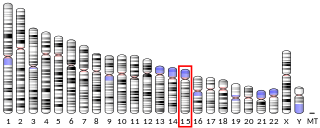
b(0,+)-type amino acid transporter 1, also known as b(0,+)AT1, is a protein which in humans is encoded by the SLC7A9 gene.

Olfactory receptor 4F4 is a protein that in humans is encoded by the OR4F4 gene.

Olfactory receptor 8B2 is a protein that in humans is encoded by the OR8B2 gene.

Olfactory receptor 2B2 is a protein that in humans is encoded by the OR2B2 gene.

Olfactory receptor 4B1 is a protein that in humans is encoded by the OR4B1 gene.

Olfactory receptor 7G1 is a protein that in humans is encoded by the OR7G1 gene.

Olfactory receptor 6B1 is a protein that in humans is encoded by the OR6B1 gene.

Olfactory receptor 6B3 is a protein that in humans is encoded by the OR6B3 gene.

Olfactory receptor 8B12 is a protein that in humans is encoded by the OR8B12 gene.

Olfactory receptor 52B2 is a protein that in humans is encoded by the OR52B2 gene.

Olfactory receptor 8B4 is a protein that in humans is encoded by the OR8B4 gene.

Olfactory receptor 1B1 is a protein that in humans is encoded by the OR1B1 gene.

Olfactory receptor 2A1/2A42 is a protein that in humans is encoded by the OR2A1 gene.

Olfactory receptor 51B6 is a protein that in humans is encoded by the OR51B6 gene.

Olfactory receptor 56B1 is a protein that in humans is encoded by the OR56B1 gene.

Olfactory receptor 6B2 is a protein that in humans is encoded by the OR6B2 gene.

Olfactory receptor 5B12 is a protein that in humans is encoded by the OR5B12 gene.

Olfactory receptor 7G2 is a protein that in humans is encoded by the OR7G2 gene.

Olfactory receptor 7G3 is a protein that in humans is encoded by the OR7G3 gene.

Zinc finger protein 471 is a protein that in humans is encoded by the ZNF471 gene.








